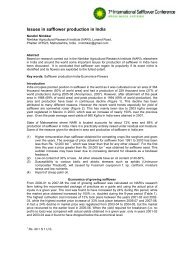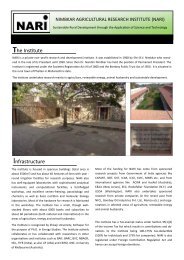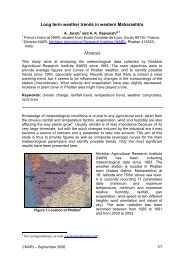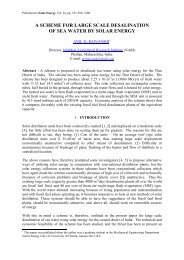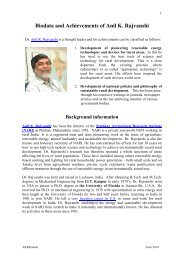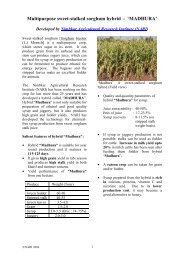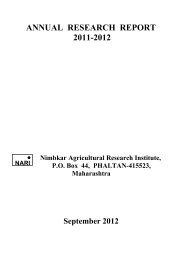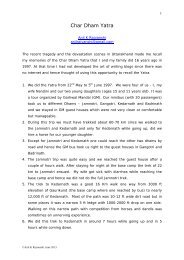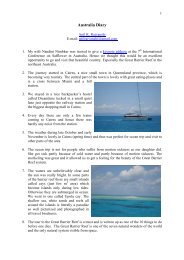3639_C006.fm Page 176 Wednesday, July 19, 2006 1:30 PM176 GENETIC RESOURCES, CHROMOSOME ENGINEERING, AND CROP IMPROVEMENTis found in west and central Asia, as well as in the Mediterranean region; and Carduncellus is grownin the western European region of the Mediterranean, northern Africa, Egypt, and Israel/Palestine.The new genus <strong>Carthamus</strong> is further subdivided into three sections.1. Section <strong>Carthamus</strong>, having 24 chromosomes, is composed of species C. curdicus Hanelt,C. gypsicola Ilj, C. oxyacanthus Bieb, C. palaestinus Eig., C. persicus Wild, and C. <strong>tinctorius</strong> L.The grouping of C. nitidus Boiss (2n = 24) along with the above species is questionable; therefore,the species is isolated from the rest of the genera to form a separate section.2. Section Odontagnathius (DC.) Hanelt (including section Lepidopappus Hanelt) has 20 or22 chromosomes and consists of the species C. boissier Halacsy, C. dentatus Vahl., C. divaricatusBeguinot and Vace. (2n = 22 chromosomes), C. glaucus Bieb., C. leucocaulos Sm., and C. tenuis(Boiss & Bl.) Bornm.Section Atractylis Reichenb is indicated to have n = 11 chromosomes producing numerouspolyploids, including the species C. lanatus L., C. creticus (C. baeticus (Boiss & Reuter) Nyman),and C. turkestanicus M. Popov.6.4.1.3 Molecular Classification of <strong>Carthamus</strong>Molecular classification of the genus <strong>Carthamus</strong> groups species into two sections (Vilatersanaet al., 2005).1. Section <strong>Carthamus</strong>: This section consists of the same species as are furnished above under section<strong>Carthamus</strong> proposed by Lopez-Gonzalez (1990).2. Section Atractylis: This section includes sections Atractylis, Lepidopappus, and Odontagnathiusas indicated in the classification suggested by Hanelt (1963), and it coincides with the old genusKentrophyllum. The only possible point of dispute in this molecularly redefined section Atractylisis the inclusion of C. nitidus having chromosome number n = 12, as the rest of the members ofthe section have n = 11 and n = 10. The relationship between species with n = 10, 11, and 12, asindicated, is a priori disconcerting but was explained in terms of descending dysploidy (Vilatersanaet al., 2000) with the exclusion of the hybridogenic basic number n = 32 from the dysploid series.Further study revealed that molecular analysis does not support the usually adopted subspecifictreatment for C. glaucus ssp. alexandrinus (Hanelt, 1963), C. glaucus ssp. tenuis (Schank andKnowles, 1964), C. lanatus ssp. creticus, and C. lanatus ssp. turkestanicus (Hanelt, 1963). Instead,the study strongly favors specific treatment for them because the four purported species do notform groups together with the species to which they are subordinated. Only C. creticus was foundto be associated with C. lanatus. But in this case, the subspecific treatment was already inadequate,as C. lanatus is one of the progenitors of the allopolyploid C. creticus (Khidir and Knowles, 1970),and on this basis, C. creticus cannot be treated as a subspecies of C. lanatus.6.4.2 Classical Cytogenetics<strong>Carthamus</strong> cytology has been extensively studied by Knowles and his coworkers in the early1960s and 1970s. (Ashri and Knowles, 1960; Hanelt, 1963; Schank and Knowles, 1964; Harveyand Knowles, 1965; Khidir and Knowles, 1970; Estilai and Knowles, 1976; Estilai, 1977). However,most of these studies, as stated earlier, were carried out to determine chromosome numbers indifferent species and the extent of pairing in interspecific crosses to establish the genomic relationshipamong species. Attempts to assign genes to chromosomes are completely lacking in this crop,although Estilai and Knowles (1980) did identify one primary and one secondary trisomic in theprogeny of an open pollinated triploid plant and used them for assigning genes to chromosomesin safflower. The identification of additional chromosomes was presumably not possible due torelatively short chromosomes of more or less equal size (Knowles and Schank, 1964). Thoughthese aneuploids were reported to be morphologically different from diploid plants, no effort was
3639_C006.fm Page 177 Wednesday, July 19, 2006 1:30 PMSAFFLOWER (CARTHAMUS TINCTORIUS L.) 177made to relate their morphological differences to the presence of extra chromosomes, mainlybecause progenies from open-pollinated plants had diverse genetic background (Knowles andSchank, 1964). Somatic chromosomes of C. nitidus Boiss were observed to be similar to those ofC. <strong>tinctorius</strong>, except the sat-chromosome of C. nitidus, which was found to be larger. Kumar et al.(1981) reported three sat-chromosomes in C. <strong>tinctorius</strong>, compared to one reported by Knowles andSchank (1964). Kumar et al. (1981) carried out detailed karyotype analysis, including measurementsof chromosome length and arm ratios, to identify translocation homozygotes in safflower. Thisstudy showed the identification of 10 translocation homozygotes out of 42 translation heterozygotesisolated in the M 1 generation of gamma-irradiated populations. The chromosomes involved ininterchange homozygotes were 6-8 (line 58), 1-3 (line 66), 3-12 (line 123), 3-10 (line 131), 3-6(line 153), 4-6 (line 186), 4-8 (line 197), 3-8 (lines 208 and 279), and 5-9 (line 290). Chromosome 3(sat-chromosome) was involved in 6 of the 10 translocations, and thus the segment interchangeswere not random.The karyological characterization of individual chromosomes and the association of genes tospecific chromosomes are lacking; as a result, a genetic and linkage map has not been developedin safflower.6.4.3 Molecular CytogeneticsFluorescence in situ hybridization (FISH) is very useful in the identification of chromosomesand provides the information required for integration of genetic and physical maps, for localizationof repetitive DNA sequences on the chromosomes, and to assist in functional and structural analysisof chromosomes. FISH analysis in C. <strong>tinctorius</strong> using p C t k p nI-1 and p C t k p nI-2 repeated sequencessimultaneously revealed that the p C t k p nI-1 sequence was exclusively localized at subtelomericregions on most of the chromosomes; however, the p C t k p nI-2 sequence was distributed on twonucleolar and one nonnucleolar chromosome pairs (Raina et al., 2005). The p C t k p nI-2 sequencealso constituted the satellite and the intervening chromosome segment between the primary andsecondary constrictions in two nucleolar chromosome pairs. The pC t k p nI-2 repeated sequence,showing partial homology to the intergenic spacer (IGS) of 18S 25S ribosomal RNA genes of anAsteraceae taxon (Centaurea stoebe), and the 18S 25S rRNA gene cluster were located at independent,but juxtaposed sites in the nucleolar chromosomes (Raina et al., 2005). The application ofFISH to other species will unravel the phylogenetic and evolutionary pathways in <strong>Carthamus</strong>.6.5 GERMPLASM RESOURCESIn view of the large number of species in safflower, the crop has enormous diversity in thegermplasm for different traits. Despite this, the exchange of genetic material between cultivatedand allied species is lacking due to the sterile nature of hybrids (Ashri and Knowles, 1960). Thisindicates that there has been no exchange of genetic material between cultivated species and thespecies possessing other than 2n = 24 chromosomes. The instances of natural crossings betweencultivated species C. <strong>tinctorius</strong> and its wild relative C. oxyacantha with 2n = 24 chromosomes havebeen observed near Isfahan in Iran and in the experimental field at the Abu Ghraib station nearBaghdad in Iraq. However, the possibility of such crossing is very limited, particularly in India andPakistan, as harvesting of C. <strong>tinctorius</strong> is over when C. oxyacantha starts to flower (Ashri andKnowles, 1960). No instances of natural crossing between C. <strong>tinctorius</strong> and C. palaestinus, theother wild relative with 2n = 24 chromosomes, has been reported, as they naturally grow in differentgeographic areas of the world. The introgression of genes from wild relatives to C. <strong>tinctorius</strong> hasnot received due attention in safflower because instances of such introgression are few. However,introgression of phytophthora root rot resistance gene from a wild composite of 12 species intocultivated safflower has been recorded (Rubis, 1981). Heaton (1981) suggested the use of C. lanatus
- Page 1: 3639_C006.fm Page 167 Wednesday, Ju
- Page 4 and 5: 3639_C006.fm Page 170 Wednesday, Ju
- Page 6 and 7: 3639_C006.fm Page 172 Wednesday, Ju
- Page 8: 3639_C006.fm Page 174 Wednesday, Ju
- Page 13 and 14: 3639_C006.fm Page 179 Wednesday, Ju
- Page 15 and 16: 3639_C006.fm Page 181 Wednesday, Ju
- Page 17 and 18: 3639_C006.fm Page 183 Wednesday, Ju
- Page 19 and 20: 3639_C006.fm Page 185 Wednesday, Ju
- Page 21 and 22: 3639_C006.fm Page 187 Wednesday, Ju
- Page 23 and 24: 3639_C006.fm Page 189 Wednesday, Ju
- Page 25 and 26: 3639_C006.fm Page 191 Wednesday, Ju
- Page 27 and 28: 3639_C006.fm Page 193 Wednesday, Ju



